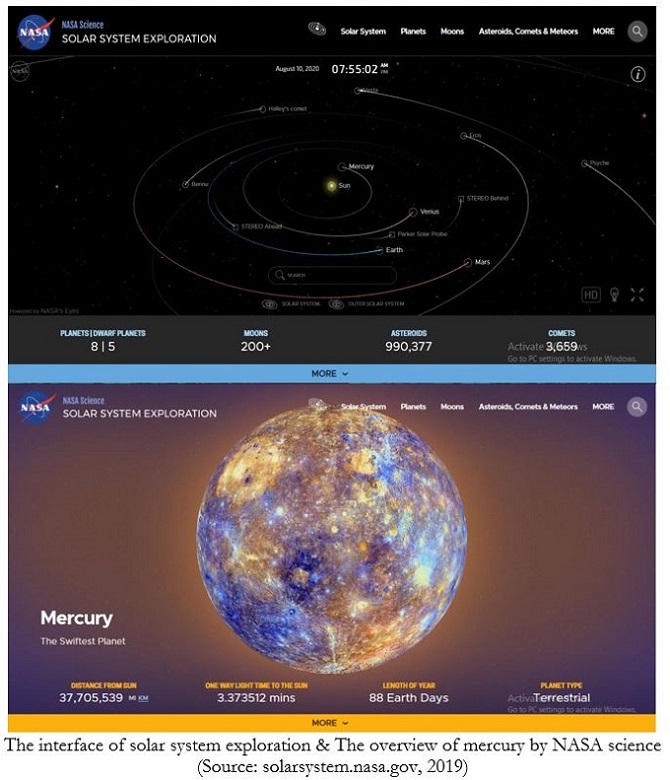
Enhancing Students’ Critical Thinking through NASA Science as Interactive Multimedia in Learning Solar System
Abstract
Full Text:
DOWNLOAD PDFReferences
Ahn, J., & McEachin, A. (2017). Student enrollment patterns and achievement in Ohio’s online charter schools. Educational Researcher, 46(1), 44-57.
Bhakti, S. S., Setyadin, A. H., Hidayat, S. R., Zulfikar, A., Fratiwi, N. J., Amalia, S. A., & Siahaan, P. (2019). Enhancing Students’ Critical Thinking Skills through Multimedia Based Integrated Instruction (MBI2) on Solar System Concept. In Journal of Physics: Conference Series (Vol. 1204, No. 1, p. 012034). IOP Publishing.
Binkley, M., Erstad, O., Herman, J., Raizen, S., Ripley, M., Miller-Ricci, M., & Rumble, M. (2012). Defining twenty-first-century skills. In assessment and teaching of 21st-century skills (pp. 17-66). Springer, Dordrecht.
Creswell, J. W. (2014). Research design: Qualitative, quantitative, and mixed methods approach. London: Sage publications.
DiBiase, W., & McDonald, J. R. (2015). Science teacher attitudes toward inquiry-based teaching and learning. The Clearing House: A Journal of Educational Strategies, Issues, and Ideas, 88(2), 29-38.
Djamas, D., & Tinedi, V. (2018). Development of Interactive Multimedia Learning Materials for Improving Critical Thinking Skills. International Journal of Information and Communication Technology Education (IJICTE), 14(4), 66-84.
Dwyer, C. P., Hogan, M. J., & Stewart, I. (2014). An integrated critical thinking framework for the 21st Century. Thinking skills and creativity, 12, 43-52.
Ekanayake, S. Y., & Wishart, J. (2014). Mobile phone images and video in science teaching and learning. Learning, Media and Technology, 39(2), 229-249.
Ercan, O. (2014). The Effects of Multimedia Learning Material on Students' Academic Achievement and Attitudes towards Science Courses. Journal of Baltic Science Education, 13(5), 608-621.
Facione, P. A. (2015). Critical thinking: What it is and why it counts. Insight Assessment, 2007(1), 1-23.
Fraenkel, J. R., Wallen, N. E., & Hyun, H. H. (2012). How to design and evaluate research in education. New York: McGraw-Hill Humanities/Social Sciences/Languages.
Hake, R. R. (1999). American Educational Research Association’s Division D, Measurement and Research Methodology: Analyzing Change/Gain Scores. USA: Wooland Hills.
Halpern, D. F. (2014). Critical thinking across the curriculum: A brief edition of thought & knowledge. New York: Routledge.
Hsiao, E. (2017). A design case of scaffolding hybrid/online student-centered learning with multimedia. Journal of Educators Online, 14(1), n1.
Kaewkiriya, T. (2013). A design and development of e-learning content for multimedia technology using a multimedia game. International Journal of Software Engineering & Applications, 4(6), 61.
Lamb, R., Firestone, J., Schmitter-Edgecombe, M., & Hand, B. (2018). A computational model of student cognitive processes while solving a critical thinking problem in Science. The Journal of Educational Research, 112(2), 243-254.
Leow, F. T., & Neo, M. (2014). Interactive multimedia learning: Innovating classroom education in a Malaysian university. Turkish Online Journal of Educational Technology-TOJET, 13(2), 99-110.
Marina, R., & Prima, E. C. (2020). Stellarium is an Interactive Multimedia to Enhance Students' Understanding and Motivation in Learning Solar System. Proceedings of the Mathematics, Science, and Computer Science Education International Seminar. European Alliance for Innovation.
NASA Science. (2019). About Us – NASA Solar System Exploration. Retrieved from https://solarsystem.nasa.gov/about-us/
NASA Science. (2019). NASA Solar System Exploration. Retrieved from https://solarsystem.nasa.gov/solar-system/our-solar-system/overview/
Organization for Economic Co-operation and Development. (2019). Indonesia - Country Note - PISA 2018 Results. Paris: OECD publishing.
Peraturan Menteri Pendidikan dan Kebudayaan Republik Indonesia No. 20. (2016). Standar Kompetensi Lulusan Pendidikan Dasar dan Menengah.
Peraturan Pemerintah Republik Indonesia No. 19. (2005). Standar Nasional Pendidikan (Cat. no. 41).
Saido, G. M., Siraj, S., Nordin, A. B. B., & Al-Amedy, O. S. (2018). Higher-order thinking skills among secondary school students in science learning. MOJES: Malaysian Online Journal of Educational Sciences, 3(3), 13-20.
Sausan, I., Saputro, S., & Indriyanti, N. Y. (2020). A New Chemistry Multimedia: How Can It Help Junior High School Students Create a Good Impression. International Journal of Instruction, 13(4).
Suherman, E. (2003). Evaluasi pembelajaran matematika. Bandung: JICA UPI.
Swandi, A., Amin, B. D., & Muin, F. (2018). 21st-century physics learning in senior high school through interactive computer simulation to enhance students’ achievement. In International Conference on Mathematics and Science Education of Universitas Pendidikan Indonesia (Vol. 3, pp. 130-135).
Tiruneh, D. T., De Cock, M., Weldeslassie, A. G., Elen, J., & Janssen, R. (2017). Measuring critical thinking in physics: Development and validation of a critical thinking test in electricity and magnetism. International Journal of Science and Mathematics Education, 15(4), 663-682.
Weay, A. L., & Masood, M. (2015). The “Big Picture” of Thematic Multimedia Information Representation in Enhancing Learners’ Critical Thinking and History Reasoning. Procedia-Social and Behavioral Sciences, 197, 2058-2065.
DOI: https://doi.org/10.17509/jsl.v4i4.27563
Refbacks
- There are currently no refbacks.
Copyright (c) 2021 Nurul Azizah Al Mar' Ati, Eka Cahya Prima, Agus Fany Chandra Wijaya

This work is licensed under a Creative Commons Attribution-ShareAlike 4.0 International License.


Jl. Dr. Setiabudhi 229 Bandung 40154, West Java, Indonesia











